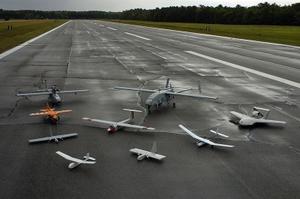UAV updateTeal Group: global UAV market to total $94 billion in the next ten years
Unmanned Aerial Vehicles (UAVs) have been the most dynamic growth sector of the world aerospace industry this decade; a new market study estimates that UAV spending will almost double over the next decade from current worldwide UAV expenditures of $5.9 billion annually to $11.3 billion, totaling just over $94 billion in the next ten years

Different drone configurations support a variety of missions // Source: wikienergia.com
Unmanned Aerial Vehicles (UAVs) have been the most dynamic growth sector of the world aerospace industry this decade, Teal Group analysts say in a new market analysis.
Teal Group’s 2011 market study estimates that UAV spending will almost double over the next decade from current worldwide UAV expenditures of $5.9 billion annually to $11.3 billion, totaling just over $94 billion in the next ten years.
“The UAV market will continue to be strong despite cuts in defense spending,” Philip Finnegan, Teal Group’s director of corporate analysis and an author of the study, is quoted by a Teal Group release to say. “UAVs have proved their value in Iraq and Afghanistan and will be a high priority for militaries in the United States and worldwide.”
The study suggests that the United States will account for 77 percent of the worldwide RDT&E spending on UAV technology over the next decade, and about 69 percent of the procurement. “We expect that the sales of UAVs will follow recent patterns of high-tech arms procurement worldwide, with the Asia-Pacific representing the second largest market, followed very closely by Europe,” said Teal Group senior analyst Steve Zaloga, one of the authors of the 458-page study. “Africa and Latin America are expected to continue to be very modest markets for UAVs.”
The eighth edition of the sector study, World Unmanned Aerial Vehicle Systems, Market Profile and Forecast 2011, examines the worldwide requirements for UAVs, including UAV payloads and companies, and provides 10-year forecasts by country, region, and classes of UAVs.
Note that Teal Group analysts already cover the UAV market in their World Missiles and UAV Briefing, which examines the UAV market on a program-by-program basis. The sector study examines the UAV market from a complementary perspective, namely national requirements, and includes both a comprehensive analysis of UAV system payloads and key UAV manufacturers.
The study also includes a UAV Manufacturers Market Overview that reflects the worldwide UAV market “continuing as one of the prime areas of growth for defense and aerospace companies,” said Finnegan. The group says the new study reflects the rapid growth of interest in the UAV business by increasing the number of companies covered to some thirty-five US, European and Israeli companies, and discusses the reshaping of the industrial environment.
“Smaller companies can successfully compete against larger players, as AAI Corp., Insitu, General Atomics and AeroVironment have all shown,” Finnegan said. “Now the prime contractors are buying the successful smaller companies.” In the past year, L-3 Communications bought Airborne Technologies, a small UAV developer and manufacturer, and VT Group purchased Evergreen’s UAV fee-for-service operations.
As prime contractors and small companies compete in the dynamic UAV market, they are adopting widely different strategies. “Our overview tracks the widely varying approaches being taken by these key companies, ranging from outright acquisitions to teaming arrangements and internal development of new UAV systems,” said Finnegan.
